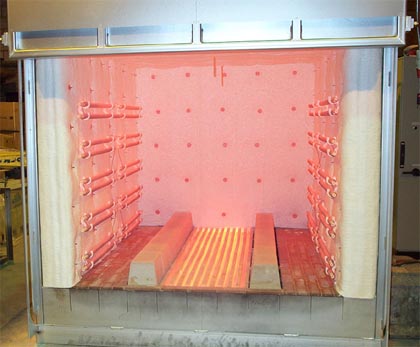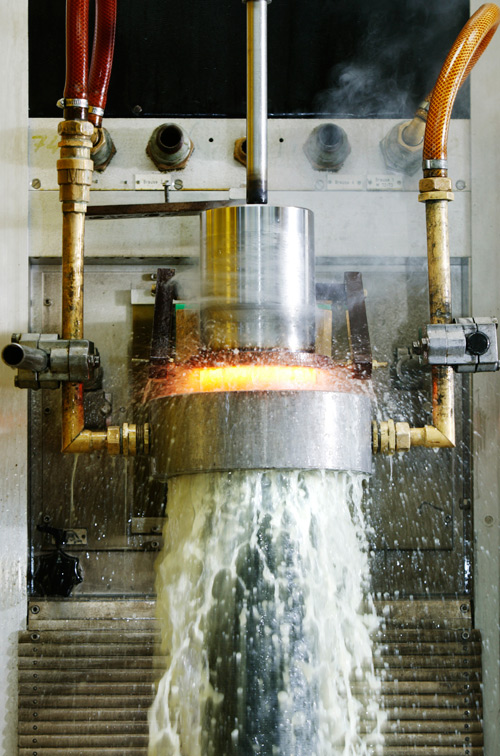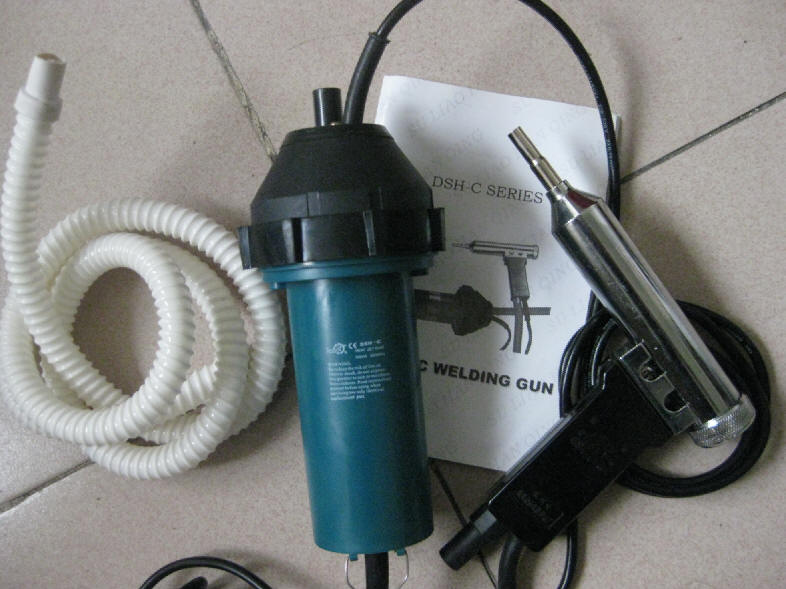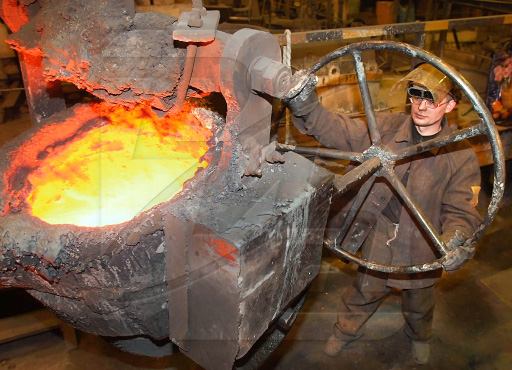What is Induction Heating ?
Induction heating is a process which is used to bond, harden or soften metals or other conductive materials. For many modern manufacturing processes, induction heating offers an attractive combination of speed, consistency and control. The basic principles of induction heating have been understood and applied to manufacturing since the 1920s.
Induction Heating Process
Induction heating relies on the unique characteristics of radio frequency (RF) energy - that portion of the electromagnetic spectrum below infrared and microwave energy. Induction heating is the process of heating an electrically conducting object (usually a metal) by electromagnetic induction, where eddy currents (also called Foucault currents) are generated within the metal and resistance leads to Joule heating of the metal.
Induction Heating - Heating the Bolt
An induction heater (for any process) consists of an electromagnet, through which a high-frequency alternating current (AC) is passed. Heat may also be generated by magnetic hysteresis losses in materials that have significant relative permeability. Induction heating is a non-contact heating process. It uses high frequency electricity to heat materials that are electrically conductive.
Since it is non-contact, the heating process does not contaminate the material being heated. It is also very efficient since the heat is actually generated inside the workpiece.
This can be contrasted with other heating methods where heat is generated in a flame or heating element, which is then applied to the workpiece. For these reasons Induction Heating lends itself to some unique applications in industry.
Induction heating allows the targeted heating of an applicable item for applications including surface hardening, melting, brazing and soldering and heating to fit.
Iron and its alloys respond best to induction heating, due to their ferromagnetic nature. Eddy currents can, however, be generated in any conductor, and magnetic hysteresis can occur in any magnetic material.
Induction heating has been used to heat liquid conductors (such as molten metals) and also gaseous conductors (such as a gas plasma - see Induction plasma technology). Induction heating is often used to heat graphite crucibles (containing other materials) and is used extensively in the semiconductor industry for the heating of silicon and other semiconductors. Supply frequency (mains, 50/60 Hz) induction heating is used for many lower cost industrial applications as inverters are not required.
How exactly does induction heating work? It helps to have a basic understanding of the principles of electricity. When an alternating electrical current is applied to the primary of a transformer, an alternating magnetic field is created. According to Faraday’s Law, if the secondary of the transformer is located within the magnetic field, an electric current will be induced.
In a basic induction heating setup shown at right, a solid state RF power supply sends an AC current through an inductor (often a copper coil), and the part to be heated (the workpiece) is placed inside the inductor. The inductor serves as the transformer primary and the part to be heated becomes a short circuit secondary. When a metal part is placed within the inductor and enters the magnetic field, circulating eddy currents are induced within the part.
As shown in the second diagram, these eddy currents flow against the electrical resistivity of the metal, generating precise and localized heat without any direct contact between the part and the inductor. This heating occurs with both magnetic and non-magnetic parts, and is often referred to as the “Joule effect”, referring to Joule’s first law – a scientific formula expressing the relationship between heat produced by electrical current passed through a conductor.
Secondarily, additional heat is produced within magnetic parts through hysteresis – internal friction that is created when magnetic parts pass through the inductor.
Magnetic materials naturally offer electrical resistance to the rapidly changing magnetic fields within the inductor. This resistance produces internal friction which in turn produces heat.
In the process of heating the material, there is therefore no contact between the inductor and the part, and neither are there any combustion gases. An induction furnace uses induction to heat metal to its melting point. Most induction furnaces consist of a tube of water-cooled copper rings surrounding a container of refractory material.
Induction Heat Treatment Equipment
Induction furnaces often emit a high-pitched whine or hum when they are running, depending on their operating frequency. Metals melted include iron and steel, copper, aluminium, and precious metals. Vacuum furnaces make use of induction heating for the production of specialty steels and other alloys that would oxidize if heated in the presence of air.
A similar, smaller-scale process is used for induction welding. Induction heating is often used in the heat treatment of metal items. The most common applications are induction hardening of steel parts, induction soldering/brazing as a means of joining metal components and induction annealing to selectively soften a selected area of a steel part.
Induction Heating Working
Induction heating can produce high power densities which allow short interaction times to reach the required temperature. This gives tight control of the heating pattern with the pattern following the applied magnetic field quite closely and allows reduced thermal distortion and damage. The depth of induction hardened patterns can be controlled through choice of induction-frequency, power-density and interaction time.
A source of high frequency electricity is used to drive a large alternating current through a coil. This coil is known as the work coil. The workpiece to be heated is placed within this intense alternating magnetic field. The alternating magnetic field induces a current flow in the conductive workpiece. This causes tremendous currents to flow through the workpiece. The skin effect increases the effective resistance of the metal to the passage of the large current. Therefore it greatly increases the heating effect caused by the current induced in the workpiece.
The barrel melting the plastic material is insulated with 15 mm ceramic insulation and in that way a) heat is not escaping to the environment and we have significant energy saving b) the induction coils are not getting heated up from the heat generated in the barrel so they operate in low temperature resulting in long life expectancy when ornery heater band elements if insulation is used there life expectancy is reduced dramatically
In induction cooking, an induction coil in the cook-top heats the iron base of cookware. Copper-bottomed pans, aluminium pans and other non-ferrous pans are generally unsuitable. Benefits of induction cookers include efficiency, safety (the induction cook-top is not heated itself) and speed. Both installed and portable induction cookers are available. Currents induced in a tube run along the open seam and heat the edges resulting in a temperature high enough for welding.
You might also like
| Heat Treatment Furnaces Heat Treatment Furnaces of Steel Heat treating... | Surface Hardening What is Surface Hardening ? Surface hardening... | What is Plastic Welding ? Welding Plastic Definition Plastic welding... | Foundry and Casting Foundry and Casting - Overview A foundry... |




 Alloy Suppliers
Alloy Suppliers
 Aluminum
Aluminum
 Aluminum Extrusions
Aluminum Extrusions
 Copper-Brass-Bronze
Copper-Brass-Bronze
 Nickel
Nickel
 Magnets
Magnets
 Stainless Steel
Stainless Steel
 Stainless Steel Tubing
Stainless Steel Tubing
 Steel Service Centers
Steel Service Centers
 Titanium
Titanium
 Tungsten
Tungsten
 Wire Rope
Wire Rope